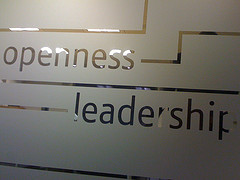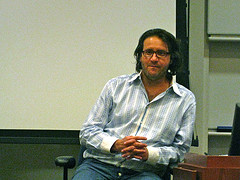|
|
|
Thursday, March 6th, 2014

Many founders talk about the desire to build truly open cultures.
Then they start adding exceptions and caveats, especially when it comes to compensation—whether dollars or stock.
Sharing compensation information is usually discouraged and discussing stock options or salary may even be considered a firing offense.
While there are startups opting for openness, what happens over time?
Based on Whole Foods nearly 30-year trial salary openness can work.
Whole Foods co-CEO John Mackey introduced the policy in 1986, just six years after he co-founded the company. In the book, he explains that his initial goal was to help employees understand why some people were paid more than others. If workers understood what types of performance and achievement earned certain people more money, he figured, perhaps they would be more motivated and successful, too.
It takes solid planning and a culture with a real commitment to transparency and developing people over time to make it work.
By making it’s financials, including profitability, available to all it employees, so they could see not just what everyone was paid, but where else the money went, Whole Foods created a true feeling of ownership along with the knowledge that promotion was available and the support to make it happen.
The company’s openness even drew recognition from the Federal Government.
In fact, in the late 1990s the widespread availability of so much detailed financial data led the SEC to classify all of the company’s 6,500 employees as “insiders,”
Building openness into your culture requires support and full buy-in from your senior staff.
And that means being willing to pass on people who have the right skills, but not the right attitude.
Flickr image credit: Paul Downey
Posted in Compensation, Entrepreneurs, Stock Options | No Comments »
Tuesday, March 4th, 2014

Culture is recognized as the “make or break” for companies of all sizes, so it’s logical for bosses at all levels to look for insights on creating and retaining a winning culture.
Zappos and Southwest are often held up as icons of good culture, but they also know that sustaining their culture doesn’t happen by accident—it takes consistent hard work at all levels.
They know that certain behaviors and actions must be actively managed, as well as made visible to the organization at large.
Companies with the most effective culture seek out and continually reinforce what Charles Duhigg, author of The Power of Habit: Why We Do What We Do in Life and Business (Random House, 2012), calls “keystone habits.” A keystone habit, Duhigg has noted, is “a pattern that has the power to start a chain reaction, changing other habits as it moves through an organization.” Companies that recognize and encourage such habits stand to build cultures with influence that goes beyond employee engagement and directly boosts performance.
The inherent problem that accounts for why these cultures are rarely created and, when they are, don’t have the lasting power bosses would like to see is a long way from rocket science.
The problem is, in fact, extremely simple.
Culture is more talked than walked.
Good cultures require well-thought-out, planned conscious effort.
And not just at conception, but for as long as they exist.
And sustained, well thought-out, planned, conscious effort requiring ongoing hard work is not the hallmark of most companies from startups through the Fortune 50.
Flickr image credit: David DeHetre
Posted in Culture, Ducks In A Row | No Comments »
Thursday, January 30th, 2014

Founders love styling themselves as CEOs.
(I did it too, back when I started RampUp Solutions.)
It says you are in charge; the boss.
Plus, it sounds cool.
As CEO, you are responsible for formulating and articulating the company’s vision to employees, investors and the media.
Heady stuff.
You are also directly responsible for creating a winning culture, developing viable financial plans, instituting a solid hiring process and a wide range of other administrative actions.
No matter what happens—good, bad, or indifferent—you are the person held responsible for everything by the board, investors, employees and media.
As the company grows there are more business and human headaches meaning less time for hands-on creativity.
CEO isn’t a 70, 80 or even 100 hour a week job; it’s a 168 hour, 24/7 job.
It’s not the right job or even a good job for many founders.
Founders need to understand that giving up the CEO role can be the smartest, wisest, and most perceptive decision they will ever make (just ask Brad Feld).
Flickr image credit: TechCocktail
Posted in Entrepreneurs | No Comments »
Friday, April 19th, 2013
A Friday series exploring Startups and the people who make them go. Read allIf the Shoe Fits posts here
 Jody Foster is chair of the department of psychiatry at Pennsylvania Hospital; immediately after receiving her MBA she has a very different experience assessing startup teams for VCs considering investing. Jody Foster is chair of the department of psychiatry at Pennsylvania Hospital; immediately after receiving her MBA she has a very different experience assessing startup teams for VCs considering investing.
…to understand who the main players in that company were, how the team functioned together, what kinds of personalities they had, and which ones needed watching as the company, and the venture capitalists’ investment, grew.
I’ve said for years that people aren’t faucets and can’t/don’t turn their feelings and attitudes on and off depending where they are; Foster puts it differently.
“People are people, no matter what industry they are in, and they bring their basic personalities to work,” says Foster. “When they act out in inappropriate ways — by, for example, bullying employees who work under them, compulsively micro managing, displaying narcissistic tendencies — it can be devastating to the entire workplace.”
Founders need to evaluate potential new hires as objectively as Foster would.
That means ignoring their skills and looking at the whole person warts and all.
Your team can survive a person with great attitude, but weaker skills, until they strengthen and grow.
What your team won’t survive is the so-called star with superb skills who brings with them the traits Foster mentions or any that are in direct opposition to the culture you are creating.
They will destroy you.
Image credit: HikingArtist
Posted in Entrepreneurs, Hiring, If the Shoe Fits | No Comments »
Tuesday, April 9th, 2013
 These days most CEOs acknowledge the importance of culture. These days most CEOs acknowledge the importance of culture.
Most incoming CEOs either want to protect and extend that current culture (think Apple) or radically change one that isn’t working (think Yahoo).
There is also a percentage that want to revamp the culture in their own image even whether the current culture is working (think Home Depot) or not (think Penney’s, which I wrote about last month, and that just fired their ex Apple CEO yesterday).
Red Hat CEO Jim Whitehurst was in the first group when he joined in 2007, but it was a real stretch (more like an unexpected bucket of ice).
He came from Delta Airlines command and control culture to a cultural meritocracy based on an open source mindset.
He calls it a “meritocracy” meaning leaders arise based on their brains, not their spot on an org chart.
“The chaotic nature, the fact that people can call me up whenever and often call me an idiot to my face. We yell and we debate and we have these things out. Our culture matches the culture around open source, so the people who want to be involved in open source feel at home.”
The proof that it works is in the pudding of revenues and retention.
Red Hat, the first and only open-source software maker to crack $1 billion a year in revenues, is growing like mad.
The company has about 5,700 employees now, hiring about 1,000 workers in 2012. It will hire another 600 to 800 in 2013.
Yet the attrition rate of his R&D group—the company’s biggest group of engineers—is only 1.5%, compared to an industry average of about 5%.
Those are numbers any CEO would be bragging about, no matter what industry.
While merit rules and open source attitudes are sacred, Red Hat is in no way a democracy.
Red Hat still has managers and those managers are still responsible for decisions.
“It’s about transparency not democracy, I can make wildly unpopular decisions and at times I have to do that … as long as I have gotten feedback and articulated my reasons clearly, I can do that.”
It doesn’t need to be. People don’t want to work in a company where decisions are based on majority rule; what they want is to be heard.
They want to know that their colleagues, whether bosses, peers or subordinates, will listen to them and discuss the merits of their thought/idea/complaint no matter who they are or what they do.
Even if you didn’t click any of the above links be sure to check out these 12 Red Hat Management Tips.
The more you implement them the more things will change or, as I keep telling clients, to change how they act change how you think.
Flickr image credit: Dave Lobby
Posted in Culture, Motivation, Retention | No Comments »
Tuesday, January 22nd, 2013
 Ugly culture is culture that is fragmented and doesn’t work together. Ugly culture is culture that is fragmented and doesn’t work together.
According to top researchers this is a function of the different mindsets between operational, executive and engineering.
Three viewpoints equal three cultures (requires free registration).
And while I’m certainly not anything like the experts mentioned in the article I don’t believe it’s a given.
I also find the so-called typical mindset of each group to be more a function of the past than the current, let alone future, mindsets, especially of entrepreneurs and those ascending to executive ranks and the top slots of many companies.
Granted, the larger the company the more likely to find those attitudes, but it’s not a given.
The experts see three silos, operational, executive and engineering, completely ignoring multiple other vertical and horizontal silos.
Of course, the article is 11 years old, so the question is ‘does it still apply’?
Does your workplace reflect these three silos or is the current reality far more nuanced?
Flickr image credit: Sam Wolff
Posted in Culture, Ducks In A Row | No Comments »
Thursday, January 10th, 2013

People, in all their varied glory are as Spock said, fascinating.
They come in many different flavors and ‘entrepreneur’ is one of my favorites.
Entrepreneurs come in many flavors, too. From the ones that set out to build the next Google, Facebook, Apple or Intel to the micropreneurs who just want to earn a decent living.
Within every business of any size at any stage there are tasks that are prime for avoidance.
Stuff like establishing culture; defining values; developing financial controls, etc.
All kinds of intangible infrastructure that can wait “until things calm down” or “when we’re bigger”
In other words, mañana—and we all know when that is.
Or, as Ryan Blair says, “If it’s important you’ll find a way. If it’s not, you’ll find an excuse.”
Flickr image credit: JD | Photography
Posted in Entrepreneurs | No Comments »
Tuesday, August 28th, 2012
 Recently Fast Company told the story of why the acquisition of Ben & Jerry’s worked for the giant Dutch conglomerate Unilever. Recently Fast Company told the story of why the acquisition of Ben & Jerry’s worked for the giant Dutch conglomerate Unilever.
The reason boiled down to two words: Yves Couette—the man Unilever put in as CEO—and how he maintained the culture and customer focus even as he streamlined and moved the company in new directions.
Several years ago I wrote about being ‘cultureblind’ and used Home Depot and its new CEO Bob Nardelli as a prime example of what happens when the new boss trashes the culture and more or less abandons customer service.
Last week a new article focused on how Home Depot turned itself around by harking back to its pre-Nardelli culture of customer service.
Compare the difference between Couette and Nardelli and you will have a perfect template of what to do and what not to do as a new boss no matter what level you are on.
So the next time you take over a new group, whether as CEO or a newly minted team leader, remember this useful mantra along the lines of ‘you are what you eat’: ‘culture drives profit’.
Flickr image credit: Bruce Fingerhood
Posted in Culture, Ducks In A Row | No Comments »
Tuesday, April 17th, 2012
Culture is today’s focus; it is considered the reason that companies succeed or fail and whether innovation will flourish or wither.
Culture is researched, dissected, written about and discussed; is culture a set of specific rules or a moving target, amorphous and difficult to pin down?
Perhaps it’s more like a computer, with core hardware and constantly changing software.
In computing, the term I/O refers to input, whatever is received by the system, and output, that which results when the input if processed.
Programmers know that if the input if bad what comes out of the computer won’t be any better, a phenomenon known as “garbage in/garbage out.”
GI/GO applies to culture and, for that matter, everything else in life.
 What comes out is a function of what you put in. What comes out is a function of what you put in.
Blindly accepting everything offered by even the most brilliant source will result in garbage out at some point.
Creating and sustaining good culture requires more than studying what’s worked elsewhere and best practice benchmarks; it requires critical thinking on your part.
No one person, past, present or future, has all the answers. No company has tried every possible combination of every approach conceivable.
Plus, they are not you, while your culture is you.
That means being your own computer—gathering input from all available sources, applying it to your situation, processing it—absorbing, reworking and rejecting.
The result will be at least slightly different from what you started with, because you’ve added the flavor of your own life experiences, knowledge and MAP to the mix—and that’s good, it shouldn’t be an exact copy.
Flickr image credit: John D
Posted in Culture, Ducks In A Row | No Comments »
Tuesday, February 14th, 2012
 Consider this a Valentine message from me. Consider this a Valentine message from me.
Last summer I wrote that the solution to having employees who care about their work and company was to look in the mirror, since their caring was a direct result of your management and the culture it engendered.
A few days ago Jeff Haden wrote in Inc. magazine about eight things people want that are a function of your MAP as opposed to your budget.
- Freedom
- Target
- Mission
- Expectations
- Input
- Connection
- Consistency
- Future
The words and explanations vary slightly, but this is the same advice I and dozens of other culture mavens have been saying for years.
Culture matters; it matters more than strategy, planning and even compensation.
Culture is your responsibility.
Culture is how you show you care.
Culture is you.
Whereas it’s barely possible to effectively live a personal lie, it just isn’t possible to propagate a culture based on one.
Not in ten lifetimes could you implement a culture that deviates from your basic values, your MAP, your essence.
You can provide what people crave, because you can change at any time you choose.
That’s the key, the choice is yours; it can’t be made for you by someone else or made by you because another desires it.
You can change, but only if you want to change.
Valentine’s Day is a good day to choose to start changing.
It won’t be easy; it will take more than a day; but it will take longer if you don’t start now.
Flickr image credit: AForestFrolic
Posted in Change, Culture, Ducks In A Row, Personal Growth | No Comments »
|
 Subscribe to
Subscribe to
MAPping Company Success
About Miki 
Clarify your exec summary, website, etc.
Have a quick question or just want to chat? Feel free to write or call me at 360.335.8054
The 12 Ingredients of a Fillable Req
CheatSheet for InterviewERS
CheatSheet for InterviewEEs™
Give your mind a rest. Here are 4 quick ways to get rid of kinks, break a logjam or juice your creativity!
Creative mousing
Bubblewrap!
Animal innovation
Brain teaser
The latest disaster is here at home; donate to the East Coast recovery efforts now!
Text REDCROSS to 90999 to make a $10 donation or call 00.733.2767. $10 really really does make a difference and you'll never miss it.
And always donate what you can whenever you can
The following accept cash and in-kind donations: Doctors Without Borders, UNICEF, Red Cross, World Food Program, Save the Children
*/
?>About Miki
About KG
Clarify your exec summary, website, marketing collateral, etc.
Have a question or just want to chat @ no cost? Feel free to write
Download useful assistance now.
Entrepreneurs face difficulties that are hard for most people to imagine, let alone understand. You can find anonymous help and connections that do understand at 7 cups of tea.
Crises never end.
$10 really does make a difference and you’ll never miss it,
while $10 a month has exponential power.
Always donate what you can whenever you can.
The following accept cash and in-kind donations:
|







 Jody Foster is chair of the department of psychiatry at Pennsylvania Hospital; immediately after receiving her MBA she has a very different experience
Jody Foster is chair of the department of psychiatry at Pennsylvania Hospital; immediately after receiving her MBA she has a very different experience  These days most CEOs acknowledge the importance of culture.
These days most CEOs acknowledge the importance of culture. Ugly culture is culture that is fragmented and doesn’t work together.
Ugly culture is culture that is fragmented and doesn’t work together.
 Recently Fast Company told the story of
Recently Fast Company told the story of What comes out is a function of what you put in.
What comes out is a function of what you put in. Consider this a Valentine message from me.
Consider this a Valentine message from me.
